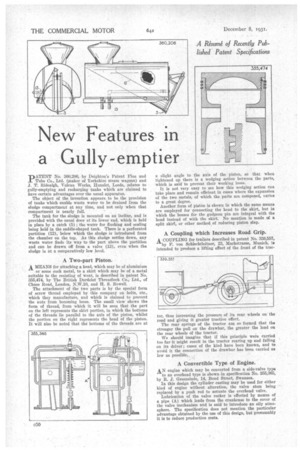New Features in a Gully-emptier
Page 72

If you've noticed an error in this article please click here to report it so we can fix it.
1DATENT No. 360,206, by Dei,ghton's Patent Flue aud Tube Co., Ltd. (paler of Yorkshire steam wagons) and J. T. Ridealgh, Vulcan Works, ilunslet, Leeds, relates to gully-emptying and recharging tanks which are claimed to have certain advantages over the usual apparatus. The object of the invention appears to be the provision of tanks which enable waste water to be drained from the sludge compartment at any time, and not only when that compartment is nearly full. The tank for the sludge is mounted on an incline, and is provided with the usual door at its lower end, which is held in place by a catch (5) ; the water for flushing and sealing being held in the saddle-shaped tank. There is a perforated partition (12), below which the sludge is introduced front the chamber on the top. As this sludge settles down, any waste water finds its way to the part above the partition and can be drawn off from a valve (13), even when the sludge is at a comparatively low level.
A Two-part Piston. A MEANS for attaching a head, which may be of aluminium
or some such metal, to a skirt which may be of a metal suitable to the resisting of wear, is described in patent No. 355,474, by The British Dardelet Threadlock Co., Ltd., of Chase Road,, London, NAVA°, and H. S. Rowell. The attachment of the two parts is by the special form of screw thread employed by this company on bolts, etc., which they manufacture, and which is claimed to prevent the nuts from becoming loose. The small view shows the form of thread, from which it will be seen that the part on the left represents the skirt portion, in which the bottoms of the threads lie parallel to the axis of the piston, whilst the portion on the right represents the head of the piston. It will also be noted that the bottoms of the threads are at
a slight angle to the axis of the piston, so that when tightened up there is a wedging action between the parts, which is said to prevent their working loose.
It is not very easy to see how this wedging action can take place and remain efficient in cases where the expansion of the two metals, of which the parts are composed, varies to a great degree.
Another form of piston is shown in which the same means are employed for connecting the head to the skirt, but in which the bosses for the gudgeon pin are integral with the head instead of with the skirt. No mention is made of a split skirt, or other method of reducing piston slap.
A Coupling which Increases RoadGrip.
A COUPLING for trailers described in patent No. 359,557, by F. von Schlechtleitner, 23, Markstrasse, Munich, ix intended to produce a lifting effect of the front of the tree
tor, thus increasing the pressure of its rear wheels on the road and giving it greater tractive effect. The rear springs of the tractor are so formed that the stronger the pull on the drawbar, the greater the load on the rear wheels of the tractor. We should imagine that if this principle were carried too far it might result in the tractor rearing up and falling on its driver ; cases of the kind have been known, and to avoid it the connection of the drawbar has been carried as low as possible.
A Convertible Type of Engine.
IN engine which may be converted from a side-valve type to an overhead type is shown in specification No. 355,365, by R. J. Greenslade, 14, Bond Street, Swansea.
In this design the cylinder casting may be used for either kind of engine without alteration, the valve stem being replaced by a push rod to actuate the overhead valve. Lubrication of the valve rocker is effected by means of a pipe (A) which leads from the crankcase to the cover of the valve mechanism and is said to introduce an oily atmosphere. The specification does not mention the particular advantage obtained by the use of this design, but presumably it is to reduce production costs.














































































































